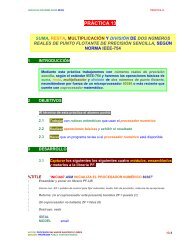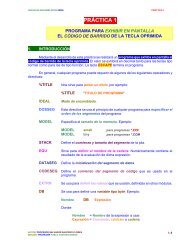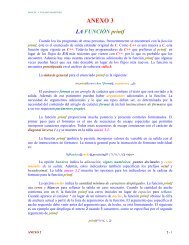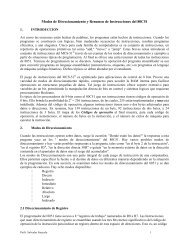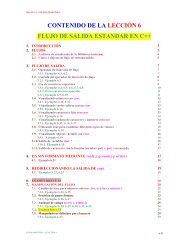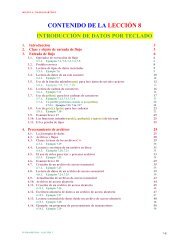CONTENIDO DE LA LECCIÓN 18
CONTENIDO DE LA LECCIÓN 18
CONTENIDO DE LA LECCIÓN 18
Create successful ePaper yourself
Turn your PDF publications into a flip-book with our unique Google optimized e-Paper software.
MIGUEL Á. TOLEDO MARTÍNEZ<br />
3. Un prototipo para una función llamada prueba() que modificará sólo un elemento en el arreglo de la<br />
pregunta 2 es:<br />
void prueba(char &elementoDelArreglo);<br />
4. Un enunciado que llamará a la función anterior para modificar el elemento almacenado en el<br />
índice[5] del arreglo en la pregunta 2 es:<br />
prueba(caracteres[5]);<br />
RESPUESTA EXAMEN BREVE 38<br />
1. La definición de un arreglo inicializado con los valores enteros de –3 a +3 es:<br />
int numeros[7] = [-3, -2, -1, 0, 1, 2, 3};<br />
o<br />
int numeros[] = [-3, -2, -1, 0, 1, 2, 3};<br />
2. La dimensión del arreglo antes mencionado es 1 x 7.<br />
3. El contenido del arreglo char lenguaje[51 = {‘C’, ‘+’, ‘+’}; es:<br />
[‘C] [‘+’] [‘+’] [‘\0’] [‘\0’]<br />
4. El contenido del arreglo char lenguaje[] = "C++"; es;<br />
[‘C] [‘+’] [‘+’] [‘\0’]<br />
5. Un carácter terminador nulo (‘\0’) se coloca en cada posición de un arreglo de caracteres definido<br />
globalmente sin ningún valor de inicialización.<br />
ARREGLOS, APUNTADORES Y ESTRUCTURAS – <strong>LECCIÓN</strong> <strong>18</strong> <strong>18</strong>-78



